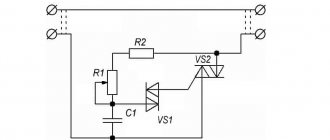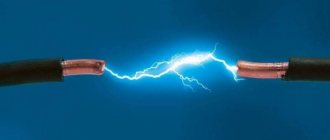Electrical injuries are common threats to humans that exist not only in the workplace, but also in the home. The degree of danger of such injuries is determined by a complex of factors, one of which is the type of electricity.
Therefore, before you start working with electricity, you need to know what danger electric current poses, which current is more dangerous - direct or alternating, and what electrical safety measures to take when working with electrical equipment.
Why is alternating current dangerous?
The peculiarity of alternating voltage is to change polarity with a certain frequency. Accordingly, the direction of electron flow changes with the same frequency. For humans, this type of electric current poses a serious threat, since it has a more pronounced stimulating effect on the nerves and muscles, including the heart.
With electric shocks, the death of victims most often occurs as a result of ventricular fibrillation , which is more likely under the influence of “change”. In addition, alternating current in the electrical network is more dangerous due to the low resistance of the human body in relation to it.
Under certain conditions, alternating voltage is almost completely safe. This is possible with its ultra-high frequency ( more than 20 kHz ). Safety is achieved due to the surface effect, due to which electricity flows only through the skin, affecting its upper layers and not penetrating into the internal organs.
Conditions for voltage occurrence
Any substance consists of atoms with a positive nucleus and negatively charged electrons.
If, under the influence of external forces, a certain number of electrons are taken away from atoms, then the resulting positive field will tend to return new negative particles in their place.
If electrons are not taken away, but added, then the field will have a negative charge. This creates positive and negative potentials. When they interact, a force of attraction arises. The greater the potential difference, the stronger the field and the higher the voltage generated.
Why is direct current dangerous?
A constant electric current flows from one pole of the circuit to the other without changing direction. A classic example of this in electrical engineering is powering consumers from batteries.
It is considered less dangerous because when it acts on a person it causes a spasm. The spasm goes away after the tension is relieved, which reduces the likelihood of critical health consequences.
However, we can talk about safety only at low DC voltage values. The higher the voltage, the stronger the danger. At voltages exceeding 500 V, direct current may be more dangerous than alternating current.
A feature of exposure at high voltage is
a stronger knockback effect than at alternating voltage. This can cause a fall and injury with serious health consequences and even death.
Which current is more dangerous and what is the main risk to humans?
Alternating electric current is the most dangerous for humans. It is often fatal because it can provoke ventricular fibrillation of the heart.
However, constant electricity cannot be considered safe either. The consequences of its impact are no less serious, including severe electrical injuries and mechanical injuries when the victim is thrown. difference is that a serious threat arises at high potential values - more than 500 V. People usually do not deal with such voltage in everyday life. However, it occurs quite often in industrial electrical installations.
It must be taken into account that electrical voltage is generally safe for humans. The threat is represented by the effective current generated by this voltage. The degree of threat depends on the value of this value. Thus, alternating current up to 10 milliamps is considered safe.
Serious danger from direct current occurs at amperages greater than 50 milliamps . The mortally dangerous value of electrical alternating current is 90-100 milliamps. At the same values, current and constant voltage are considered fatal to humans.
Why don't birds on wires get electrocuted?
Electricity is an integral element of modern life. Everyone knows how important it is to have electricity in the house, and why you can’t live without it. However, besides this, everyone also knows how dangerous electric current can be. When a person is subjected to an electric shock, within a few fractions of seconds the electricity reaches the heart and can disrupt its functioning or stop it altogether.
We've been told that we shouldn't joke with electricity since childhood, but when you watch birds sitting on high-voltage wires, the question arises, why don't the birds get electrocuted?
Quite often you can see birds sitting alone or in flocks on high-voltage wires. Despite the fact that the wires are live, the birds are not disturbed by this. If a person takes hold of a bare wire, he can be severely electrocuted, so the interest in why birds on wires are not electrocuted worries many people. It is worth looking into this issue in more detail.
The physical process of this issue
In order to understand why birds on wires are not electrocuted, you must first determine what processes occur in the wires when electric current flows through them. As everyone knows from physics lessons, electric current is a flow of moving electrons. The movement of electrons is possible only if there is a potential difference.
If we consider the explanation in more detail, it turns out that an electric current can move from a point with a large number of charged particles to a smaller one, and the difference between them will be voltage. The bird's feet are on the same wire and have no voltage difference, so they sit in complete safety.
Why don't birds on wires get electrocuted?
So, there is a wire that is energized, which does not really matter. There is also a bird that flies in the air. As everyone knows, air is one of the dielectrics and cannot conduct electric current. When a bird sits on the wires, nothing happens as a result, because it is on the same cable with both its legs.
Almost along the entire length of the electrical conductor, the voltage is always constant, so a potential difference cannot occur between one and the second leg of the bird. Considering these factors, electric current cannot flow between the bird and the wire, and the answer to the question of why birds on wires are not electrocuted is quite understandable and understandable.
When a bird sits on a live cable, it becomes a conductor, but in order for a current to appear, the animal must touch one part of its body to a point that has a lower potential. Of course, the theoretical probability of an electric shock to a bird is possible, but all the necessary conditions must be created.
It is worth noting that in order for a bird to be electrocuted, it must be large enough. In this case, the bird should not just sit on a live wire, but should come into contact with a grounded support. When all the conditions are met, the bird may be electrocuted and die, but the probability of all moments coinciding is significantly low.
It is also worth considering the fact that birds can sense an electromagnetic field and they simply do not fly up to wires with very high voltage. Birds can land on power line wires if the voltage does not exceed 330 kilowatts. Thanks to this safety system, birds can recognize where they can sit and where they should not.
Conclusion, why birds are not shocked: given that the bird’s two legs are on the same wire, there are no voltage drops and there cannot be an electric shock. Consequently, the bird can calmly sit as long as it needs on the wires and not be in danger. As a matter of fact, this is the whole secret, which is quite simple and obvious to people who know the basic laws of physics.
What happens if a person hangs on the wires?
People, like birds, can touch a live wire, but unlike our feathered friends, a person cannot fly up to the cable. Special equipment is used to work with wires at height.
Today, work with high-voltage wires is carried out by special electricians. Their direct responsibility is to maintain power lines at height. It is possible to work in such conditions if special equipment and equipment are used to ensure safety.
Working with high electrical voltage is very dangerous, which is why every company has certain instructions to ensure safe working conditions.
| The human body consists of seventy percent water, so even 0.1A of current can be fatal. To make it more clear, a 100-watt light bulb passes a current of 0.5 Amperes through itself, and literally half a second is enough for the heart’s rhythm to be disrupted and it to stop. |
Today on the Internet you can see a lot of video material showing how paratroopers land on high-voltage transmission lines. If you behave correctly in a suspended state, you can remain alive and wait until the power is turned off to descend to the ground.
Very often situations occur at home when it is necessary to correct live wiring. If you do not have certain knowledge and experience, then it is better to entrust this work to professionals who know and can even connect live wires.
If the light goes out, you can check the voltage using a special indicator. However, after such a check, you should not immediately grab the exposed wires, because perhaps the indicator simply does not work, and then there is a chance of getting an electric shock. To prevent such trouble, you can check the tension with your hand, but only with the outer part of your palm.
If you grasp a live wire with your palm, then under the influence of current, your hand will shrink and it will be problematic to unhook from the cable. By using the outer part of your palm, you will feel the stress on your hand, but you can tear your hand off, thereby avoiding big trouble.
In what cases will a bird on wires get electrocuted?
When a bird simply sits on a live cable, it will not be killed or even shaken, provided that both legs are on the same wire.
An electric shock can strike a large bird, such as a stork, an eagle or other large individuals. A bird, while flying or landing on wires, can come into contact with its wings with different potentials, resulting in an electric shock and the bird dying. If contact occurs between phase wires or a grounded support, then the death of the bird is inevitable, as a kind of short circuit occurs.
With such a short circuit, the bird's body is exposed to an electric shock of several thousand amperes, from which it is almost impossible to survive.
A bird can also be electrocuted if, when it lands on the wires, it has some object in its beak that conducts electricity (wire, wet string or wet branch). With voltages of several thousand volts, even a small current can kill a bird.
The bird can also be electrocuted if the air is sufficiently humid and the voltage in the wires is very high. Ionized humid air can conduct electric current, which can negatively affect the health and life of the bird.
Cases of bird deaths on wires from the practice of a power engineer
We often had cases when a high-voltage power line was switched off at night, and during the day dead birds (storks, crows) were found on the ground under the supports. Why, in this case, was electricity fatal for them?
The thing is that in such cases the birds sit on the upper part of the insulator garland, which is connected to the metal part of the support. The support, in turn, has a connection with the grounding circuit, that is, it is grounded. And when the bird begins to “shit” in this position, the stream of feces acts as a conductor.
In this case, the birds are in the path of the electric current. The electric current moves along the path: “wire – bird – support body (grounding).” The potential difference in this case turns out to be enormous and, unfortunately, the bird dies.
To prevent emergency shutdowns of lines due to such cases, the energy industry came up with special devices that prevent large birds from “landing” on the edge of the support; they are called “anti-bird barrier”, abbreviated as “PPZ”.
Friends, you probably noticed such devices on the supports of high-voltage lines, you just didn’t know what they were))).
Friends, I hope that the issue that worried many people was clearly disclosed. After reading this article, you will now be able to explain to your child why birds on wires do not get electrocuted. Our feathered friends are not superheroes at all. It's all about a normal physical process and electricity is just as dangerous for them as it is for people.
Reasons why birds land on wires
Birds can land on high voltage wires and be exposed to danger in a variety of situations. Firstly, it is worth understanding that birds in the air feel much calmer and safer, since there are no ground-based predators nearby.
It is for this reason that in most cases, birds choose power lines for recreation, which are located at a sufficient distance from the earth’s surface and they are available almost everywhere. Some birds make their nests on transmission line supports, so staying on the wires is understandable.
Similar materials on the site:
electricvdome.ru
Dangerous current strength for human life
Electricity can have different effects. With a low electric current, it can be completely unnoticeable or cause only mild discomfort. If this value is amperes , then the effect of the current will be dangerous to the point of death. You can evaluate the consequences of the possible action of each of the two types of electricity with different current strength (amperage) using the table data:
| Current value, mA (milliamps) | The nature of the action of electric current | |
| Constant | Variable | |
| 0.6-1.5 mA | does not appear | mild itching and tingling |
| 2-3 mA | does not appear | slight cramps appear |
| 5-7 mA | minimal skin hyperthermia and mild tingling occurs | cramps intensify, painful sensations appear |
| 8-10 mA | tingling and hyperthermia become more intense | the pain intensifies, the victim is still able to free himself from the action of the current on his own |
| 20-25 mA | in addition to increasing hyperthermia and tingling, minor cramps appear | breathing becomes difficult, paralysis of the limbs occurs, the victim is unable to free himself on his own |
| 50-80 mA | severe hyperthermia of the skin, convulsive muscle contractions, difficulty breathing | arrhythmia appears, paralysis of the respiratory muscles occurs |
| 90-100 mA | paralysis of the respiratory muscles occurs, which can lead to death | Lethal current . At 3 seconds of action, fibrillation of the cardiac ventricles develops, respiratory arrest occurs, salvation is possible only with emergency resuscitation |
These tables clearly demonstrate that alternating electric current is the most dangerous for people.
Paths of electric current passing through the human body
The threat is determined not only by the dangerous magnitude of the current, but also by the path of electricity flow through the body. The destructive effect on certain organs depends on this path.
The most dangerous electric current loops
The following pathways are considered the most threatening:
Diagram of the passage of an electric current loop hand - hand
- Hand - hand. Electricity passes through the chest, up to 3.3% of the charge enters the heart.
Diagram of the passage of an electric current loop, right arm - leg
- Right hand - legs. The danger of this loop is associated with the passage of electric current through the heart (about 6.7% of the charge). Also, part of the charge passes through the spinal cord.
Show a diagram of the passage of an electric current loop left arm - legs
- Left hand - legs. Occurs less frequently than the previous loop (usually typical for left-handed people). About 3.7% of the charge affects the heart.
Show a diagram of the passage of an electric current loop leg - leg
- Leg - leg. Characteristic when exposed to step voltage. The heart passes about 0.4% of the charge. The main threat is associated with the possibility of a person falling, as a result of which the value of the step voltage increases, and electricity passes through more dangerous loops.
Show a diagram of the passage of an electric current loop head - legs
- Head - legs. The danger is associated with the effect of electricity on the brain, spinal cord, and spine. 6.8% passes through the heart .
Show a diagram of the passage of an electric current loop head - hands
- Head - hands. One of the most dangerous loops. 7% through itself , and the brain is hit.
What types of electrical injuries exist, protective equipment and first aid
Show flow chart (Types of electric shock)
Electrical burns, depending on the nature of the impact caused to the victim, can be contact and arc. Electrical burns of the first type occur when the body comes into direct contact with a conductor. The degree of burn depends on the duration of such contact and amperage.
There are different degrees of electrical burns:
- The safest injuries are first degree , which affect only the upper layers of the skin and are expressed in its hyperthermia and slight swelling. Recovery takes place without special therapy.
- Second degree skin lesions extend deep into the germ layer . In the area affected by the electric current, blisters filled with a clear liquid form, which should not be punctured. The damaged area may be quite painful. If the affected area is small, the burn goes away without special treatment.
- The third degree is characterized by the death of cells in the inner skin layers , the formation of blisters filled with bloody fluid. Severe redness of the skin is observed in the affected area. In the worst case, it darkens, which indicates tissue necrosis. In this condition, the skin does not regenerate, so the victim requires specialized medical care.
- The most extensive injuries of the fourth degree are associated with burnout of the skin, muscles, and thermal damage to bones. This condition can pose a serious threat to life, so specialized medical care is mandatory.
Electrical marks are specific spots with clear boundaries on the surface of the skin in the area exposed to electric shock. They have a gray or pale yellow tint. The size of such spots is 1-5 mm; there is usually a depression in the center. The shape of the sign can follow the shape of the conductive part, contact with which caused its appearance. The skin in the area of the electric sign hardens. There is no pain or inflammation.
Metallization of the skin is the penetration of molten microscopic particles of conductor metal into its layers. Typically observed when a switch is turned off under load or when attempting to disconnect shorted wires.
Only exposed skin areas are affected, so the main means of preventing metallization is the use of special clothing and protective equipment when working with electrical equipment. During metallization, victims note a sensation of a foreign body and pain at the site of injury. As a rule, metallic skin gradually peels off, and injuries heal without scarring. In the first minutes, it is recommended that the victim apply a sterile bandage.
Electroophthalmia is inflammation of the eyes as a result of ultraviolet radiation from an electric arc. It occurs within 4-8 hours after irradiation of the eyes and is manifested by redness, inflammation, profuse lacrimation, and headache. In severe form, it can lead to loss of vision, so if symptoms develop, you should immediately consult a doctor.
To prevent electrophthalmia, it is necessary to wear safety glasses when working
The listed electrical injuries are local. There are also general electrical injuries , which are characterized by the negative impact of electricity on the entire body. Victims often lose consciousness and develop breathing and heart problems.
The most dangerous phenomenon is ventricular fibrillation, which often ends in death. If the victim of an electric shock is unconscious, he is immediately given cardiopulmonary resuscitation.
With electrical injuries, imaginary death often develops, in which the signs of the body’s vital functions become almost invisible, but the person can be saved. Therefore, cardiopulmonary resuscitation is carried out until the last minute.
First aid to victims of electric current is provided in the following order:
- The victim is released from the effects of electricity . In this case, the person providing assistance must take measures to ensure their own safety.
- Determine the condition of the victim - checking breathing, pulse, etc.
- They free a person from excess clothing, which makes breathing difficult.
- Examine the oral cavity and, if necessary, clean it of vomit, clots of mucus and blood.
- Cardiopulmonary resuscitation measures are initiated.
Show flowchart (Electrical injury at work)
During the provision of assistance, a sufficient supply of fresh air must be ensured in the room and unnecessary people must be removed. Persons who are not directly involved in providing first aid must call doctors and report the incident to the head of the organization (in case of a work-related injury).
You also need to examine the victim for electrical burns and apply a clean, dry bandage to them. After this you need to wait for the doctor. All cases of electrical injuries are subject to hospitalization , even in the absence or removal of dangerous symptoms. This is due to the possibility of developing fibrillation or delayed arrhythmia several hours after the lesion.
Show Flow Diagram (Factors Affecting the Outcome of Electrical Shock)
For a more detailed study of the topic of providing first aid to victims of electric current, we recommend that you familiarize yourself with the methodological material -
Additional impacts
Among other things, it is also necessary to take into account other effects that direct and alternating current creates when passing through the human body. These include:
- Electric shock. It provokes stimulation of all tissues, which leads to convulsions and their consequences. These may include loss of consciousness, respiratory or cardiac dysfunction, and death.
- Electrical injury. This is damage that is caused directly to the body. There are two types of them:
- Electrical burn. It is divided into current, which represents the passage of current through the entire body, and also arc, the appearance of which occurs between the conductor and a person. It can be clearly identified by the arc that appears upon contact. And it is also several times more dangerous than current, since its temperature can be several times higher.
- Metallization of leather. A phenomenon that means when metal particles enter the skin. The consequence of this is increased conductivity and greater risk of injury.
It is also worth remembering about electrical marks, which represent the places where the current entered and where it came out from.
Basic norms and rules of electrical safety
The key regulatory documents regulating the field of electrical safety are the following:
- Rules for the construction of electrical installations ( PUE. Edition 7, chapter 1.7 ) –
- Rules for technical operation of consumer electrical installations ( PTEEP ) –
- Rules for labor protection during operation of electrical installations –
- Instructions for the use and testing of protective equipment used in electrical installations -
When performing any work on electrical equipment, the following rules must be observed:
- When designing and installing electrical networks, emergency devices must be used that de-energize the network in the event of a short circuit (short circuit) and in the event of a short circuit to ground. The installation of a ground loop is mandatory.
- Persons with appropriate clearance are allowed to work.
- Special clothing and personal protective equipment required by regulatory requirements must be used.
- It is not allowed to turn on and use equipment and electrical appliances if there is damage to the housing, or to use cables if damage to the insulation is detected.
- It is not allowed to carry out repair work without de-energizing the network.
- Personnel must be able to provide first aid in case of electric shock to a person.
Classification of premises in relation to the danger of electric shock
Depending on certain conditions that increase the danger of exposure to electric current on a person, different rooms have different degrees of danger of electric shock - some are greater, others are less. In accordance with the Electrical Installation Rules, premises with respect to the danger of electric shock to people are classified as follows:
1. Premises without increased danger , in which there are no conditions that create increased or special danger. In such rooms, the relative air humidity is less than 60%, there is no high temperature, conductive dust, chemically active or organic environment, conductive floors, and the possibility of simultaneous contact with the metal structures of buildings, apparatus, mechanisms and metal casings of electrical equipment.
2. Premises with increased danger , characterized by the presence of one of the following conditions creating an increased danger:
- dampness (relative humidity more than 75%) or conductive dust;
- conductive floors (metal, earthen, reinforced concrete, brick, etc.);
- high temperature (temperature constantly or periodically (more than one day) exceeds 35°C);
- the possibility of simultaneous human contact with metal structures of buildings connected to the ground, with technological devices, mechanisms, etc., on the one hand, and with metal casings of electrical equipment (exposed conductive parts) on the other.
3. Particularly dangerous premises , characterized by the presence of one of the following conditions creating a particular danger:
- special dampness (relative air humidity is close to 100% - the ceiling, walls, floor and objects in the room are covered with moisture);
- chemically active or organic environment (rooms containing aggressive vapors, gases, liquids, deposits and mold that destroy insulation and live parts of electrical equipment);
- two or more high-risk conditions at the same time.
In terms of the danger of electric shock to people, the territory of open electrical installations is equated to especially dangerous premises.
How to Avoid Electric Shock
To prevent electric shock to a person, it is necessary to prevent the possibility of bodily contact with live parts and conductors. Therefore, all work is carried out using the necessary protective equipment. The main personal protective equipment of this type include dielectric gloves and boots, dielectric mats and stands, etc.
When working, be sure to use an insulated tool . Personnel are required to undergo training; workers must know how to avoid defeat. Before performing work, be sure to de-energize the corresponding section of the network . In this case, an information sign about the prohibition of turning on the network must be displayed on the switch or circuit breaker. It is not allowed to perform any manipulations with live conductors.
Indicator screwdriver HR28-C (12-250V)
You can check the presence of voltage using special indicator devices. The simplest and most accessible among such devices is an indicator screwdriver.
If there is any doubt whether the conductor is live, you must not work with it!
Video
Watch a video about alternating and direct electric current. These videos will teach you about the hazards and how to protect yourself from electrical shock.
Recommended viewing:
- Question: why can’t I install a duplicate counter?
- Various schemes for crimping twisted pair 4 and 8 cores
- Electromagnetic relay, what is it, what is the principle...
- Surge filters for electrical equipment
- Why didn't the circuit breaker trip? Video
- What is the correct name for a machine for high current...
2+
What role does body resistance play?
The resistance of the body depends on the condition of its skin; the following factors can have an influence:
- What condition is a person’s skin in? For example, it can be clean, it can be dirty, wet, damaged.
- What was the area of contact of the current with the skin?
- The magnitude of the applied voltage.
- What frequency current passed through the body.
- General condition of the human nervous system.
If the skin has been scratched or abraded, the dangerous stress may be minimal for death to occur because the body's resistance is reduced. The ability to resist is lost in a person who has a sweaty or dirty hand. For example, a voltage of 30 volts with dry hands does not cause severe pain, but if you touch it with a wet hand, a person will not be able to unclench his fingers and will feel severe pain. In such cases, it is customary to say that a breakdown of skin resistance has occurred.
Skin resistance can decrease even when a low voltage is applied, 20-40 volts.










